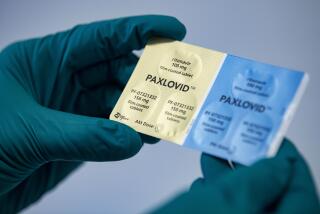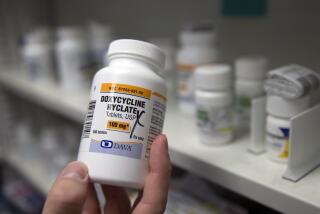New Treatments Reduce AIDS Hospitalizations
- Share via
WASHINGTON — AIDS-related hospitalizations have plummeted since potent combinations of three drugs have become the standard of care, officials with several clinics--including one from Los Angeles--reported Thursday.
But concerns have surfaced that use of the treatment is being stymied by gaps in insurance coverage. The average annual cost of using the drugs is estimated at $15,000.
The studies on the effects of the drug combinations, which included data from Tower Infectious Disease Medical Associates in Los Angeles, were presented at the fourth Conference on Retroviruses and Opportunistic Infections, a major gathering here this week devoted to combating AIDS.
Increasingly, AIDS patients have begun taking complicated drug “cocktail” regimens that include powerful protease inhibitors, a new generation of antiviral drugs, in conjunction with older AIDS therapies, known as nucleoside analogs.
However, these drugs are expensive and some patients and physicians have complained of difficulty in some states of obtaining insurance coverage to cover the costs.
“Some states have chosen not to make these drugs reimbursable, which is short-sighted,” said Dr. Robert T. Schooley, a member of the conference’s scientific program committee and a leading AIDS researcher. “Even if you didn’t care about quality and quantity of life [for AIDS patients], withholding these drugs will cost [the states] more in the long run.”
Dr. Peter Ruane, of Tower, which serves the West Los Angeles/Beverly Hills area, studied the clinic’s average monthly caseload of 482 patients from July 1994 through last December.
During this period, the average number of hospital days required for AIDS patients per month fell by 57%, from 122 days to 52, he reported.
The average number of skilled nursing or hospice days utilized by the patients per month dropped from 136.8 to 48, a reduction of 65%.
“Our hospital days began to drop when we started prescribing double combination therapy with AZT and 3TC, but they dropped farther and faster when we added protease inhibitors,” Ruane said. “These new therapies have completely transformed home health care as well. In the last six months of 1994 we had 65 people on home care. Now we have five. These drugs clearly reduce the incidence of opportunistic infections.”
The AIDS Center at St. Vincent’s Medical Center in New York reported similar reductions.
There, the study found that from 1995 to 1996 the monthly average number of hospitalized patients with AIDS declined by 24% and the average length of stay was reduced by 16%.
These reductions were reported even as the center’s AIDS caseload increased.
The new drugs have had “a dramatic effect on treatment patterns in our clinic, and on our patients’ daily lives,” said Dr. Ramon Torres, the center’s director. The result has been “fewer infections and fewer hospitalizations,” he said.
Torres added that “greater public awareness of the existence of new, potent treatment options clearly has led more people to seek care before they become seriously ill.”
Torres said that the “up-front” cost of treatment with triple-drug combinations “may be offset by subsequent declines in use of health care resources.”






